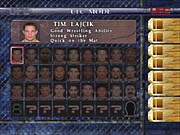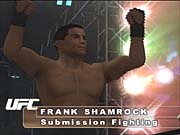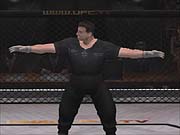UFC Tapout Preview
Are you ready for the UFC on the Xbox?
We recently had the opportunity to get our hands on the latest build of Crave Entertainment's soon-to-be-released Ultimate Fighting Championship: Tapout for the Xbox. UFC: Tapout is based on the Ultimate Fighting Championship, a mixed martial arts event that challenges fighters from around the world to go head-to-head, pitting their respective martial arts against all comers within the confines of the Octagon. Developed by Dream Factory, the group best known for its Tobal series of fighting games, UFC: Tapout borrows the same gameplay formula from last year's Dreamcast version of UFC, adds a couple of extra play modes, significantly beefs up the roster, and updates the game with improved graphics.

We've explored the different gameplay modes available, and we've found that the options available in the Dreamcast version have been expanded upon significantly. You can compete in the challenging arcade mode, vie for the championship in the UFC mode, set up a tiered tournament for multiple players, or simply fight a couple of matches in the exhibition mode. The arcade mode is the most challenging of the single-player games--you'll have one chance to take out as many CPU-controlled opponents as possible, unlocking secret fighters along the way. We had a chance to play as some of the secret fighters, and, while some are the usual suspects, there are some pleasant and rather shocking surprises to be found. The UFC mode places you in a multiple-round tournament, where you need to conserve energy, so as not to be too fatigued and beat-up for the final title bout. Completing this play mode adds a small crown icon to the selected character's information in the fighter select screen, so it appears that players may be rewarded for getting to the top with the entire cast. Like most fighting games, UFC: Tapout focuses on multiplayer competition with the tournament and exhibition modes.

If you've played the Dreamcast version of UFC, you know just what to expect from the control and gameplay of UFC: Tapout. Each fighter is controlled using four buttons mapped to right and left punches and kicks. Standing strikes can be used in combinations, with different combinations when you're stepping in or away from the opponent. Two-button combinations are used to perform counters, takedowns, and submissions, as well as to defend yourself from the same. When one fighter successfully takes his opponent down to the mat, strategy kicks in, as the positions the two fighters are in place them on significantly different footing. The player on top, typically in the mount or held in the defender's guard, will attempt to rain blows down on the defender, taking advantage of his leverage, which brings with it the ability to deal out great amounts of damage. The player on the bottom must block the incoming moves or counter by rolling into a reversal of positions. Considering the frequent jockeying for position, and the constant threat of a quick finish, ground fighting is one of the most complex aspects of the fighting system. The gameplay is remarkably deep, allowing for what may seem like multiple-round stalemates at the higher levels of play, while still allowing for the exciting flash knockouts and quick submissions that are the UFC's trademark.
One of the most impressive things about UFC: Tapout is the stellar roster of fighters that are available right off the bat. There are 27 UFC competitors available at first, including the game spokesman and current light heavyweight champ, "Hungtington Beach Bad Boy" Tito Ortiz, and kickboxing contender "The Iceman" Chuck Lidell. Coinciding with the real-world UFC's addition of multiple weight classes, UFC: Tapout now allows players to compete in openweight, heavyweight, and lightweight divisions. There are plenty of fighters to choose from, and they all have distinct styles, combos, and maneuvers. For example, Mark "The Hammer" Coleman, master of the ground and pound, has a particularly useful punch-backhand-forearm attack that easily staggers opponents, working well with his powerful takedown technique. Once on the ground with Coleman, it's rather easy to rain punishing blows down on your opponent or go for the "can opener" neck-crank submission. Representing the slimmer warriors are such fighters as current lightweight champ Jens Pulver and the exciting Japanese shooto competitor Caol Uno. Giving Tito, Coleman, and the other game veterans new competition are such luminaries as "The Titan" Mark Kerr and Dan "The Beast" Severn, one of the greatest champions in UFC history. Judging from the time we spent with the game, the intuitive control scheme makes each character essentially very similar to play, but the individual move sets and combo routines make them all interesting to learn. For example, most fighters counter punches with an arm-drag takedown, but Dan Severn uses a two-handed shove instead, which likely can be chained into some form of takedown. If you've played the first UFC extensively, you'll recognize other signature maneuvers that make their return. Frank Shamrock still counters punches with an armbar submission, and it's still especially devastating. While the gameplay is essentially identical to that of the original UFC for the Dreamcast, the updated roster should appeal to anyone who enjoyed the first.

The graphics have also seen an update, and UFC: Tapout is a very good-looking game. The ring entrances use an interesting technique in which the fighters' characters models are blended nicely with recorded FMV background footage and crowd animations. Considering the lousy spectators that most sports games employ, it's nice to see great looking venues and realistic entrances. The fighters themselves look great as well. Each competitor's face is remarkably well detailed, and the character models, as a whole, look very lifelike. Each fighter has been individually modeled, using their real-world counterparts as reference, to properly convey their builds, skin tone, and smaller details like tattoos. Their animations are equally well done, both while fighting and during entrances, where their personal characteristics really shine. Some fighters hop up and down between rounds, and after a match, Tito Ortiz humiliates the opposition with his grave-digging routine. The game also shares its blood option with last year's game on the DC, and when it's toggled to its higher setting the mat becomes doused by deep red droplets during the match. On the other hand, the sound effects we've listened to currently sound a bit forced, with overly emphasized slapping sounds and repetitive fighter noises, but hopefully they'll be worked on before release. The introductions by Bruce Buffer are coming along nicely, however, and they add significantly to the televised-broadcast feel.

We had a lot of fun with this preview build of UFC: Tapout--the game appears nearly final, and it is quite enjoyable, both going head-to-head against a human opponent and taking on the CPU. It must be said that aside from the aesthetic and roster updates, this is essentially the same game as last year's title, but that may very well be a good thing. The UFC games are the closest that video games have ever come to simulating real combat, while still emphasizing fun, challenging gameplay, and we're glad to see that last year's capable formula has been taken a step further. Stay tuned for our review of UFC: Tapout as the upcoming release date approaches.
Got a news tip or want to contact us directly? Email news@gamespot.com
Join the conversation